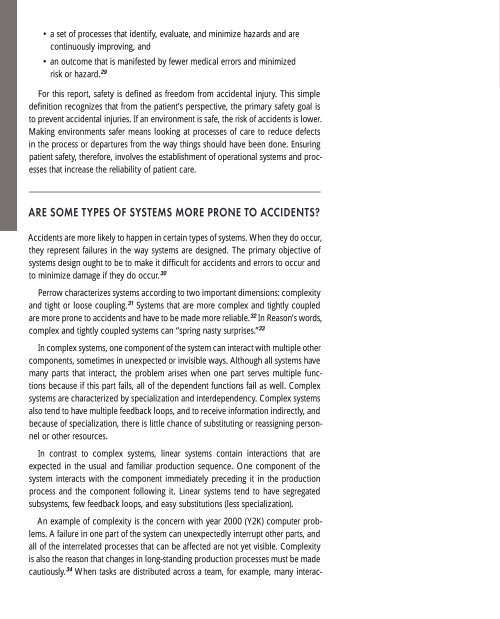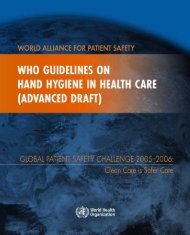Adverse event reporting.pdf
Adverse event reporting.pdf
Adverse event reporting.pdf
Create successful ePaper yourself
Turn your PDF publications into a flip-book with our unique Google optimized e-Paper software.
• a set of processes that identify, evaluate, and minimize hazards and are<br />
continuously improving, and<br />
• an outcome that is manifested by fewer medical errors and minimized<br />
risk or hazard. 29<br />
For this report, safety is defined as freedom from accidental injury. This simple<br />
definition recognizes that from the patient’s perspective, the primary safety goal is<br />
to pr<strong>event</strong> accidental injuries. If an environment is safe, the risk of accidents is lower.<br />
Making environments safer means looking at processes of care to reduce defects<br />
in the process or departures from the way things should have been done. Ensuring<br />
patient safety, therefore, involves the establishment of operational systems and processes<br />
that increase the reliability of patient care.<br />
ARE SOME TYPES OF SYSTEMS MORE PRONE TO ACCIDENTS?<br />
Accidents are more likely to happen in certain types of systems. When they do occur,<br />
they represent failures in the way systems are designed. The primary objective of<br />
systems design ought to be to make it difficult for accidents and errors to occur and<br />
to minimize damage if they do occur. 30<br />
Perrow characterizes systems according to two important dimensions: complexity<br />
and tight or loose coupling. 31 Systems that are more complex and tightly coupled<br />
are more prone to accidents and have to be made more reliable. 32 In Reason’s words,<br />
complex and tightly coupled systems can “spring nasty surprises.” 33<br />
In complex systems, one component of the system can interact with multiple other<br />
components, sometimes in unexpected or invisible ways. Although all systems have<br />
many parts that interact, the problem arises when one part serves multiple functions<br />
because if this part fails, all of the dependent functions fail as well. Complex<br />
systems are characterized by specialization and interdependency. Complex systems<br />
also tend to have multiple feedback loops, and to receive information indirectly, and<br />
because of specialization, there is little chance of substituting or reassigning personnel<br />
or other resources.<br />
In contrast to complex systems, linear systems contain interactions that are<br />
expected in the usual and familiar production sequence. One component of the<br />
system interacts with the component immediately preceding it in the production<br />
process and the component following it. Linear systems tend to have segregated<br />
subsystems, few feedback loops, and easy substitutions (less specialization).<br />
An example of complexity is the concern with year 2000 (Y2K) computer problems.<br />
A failure in one part of the system can unexpectedly interrupt other parts, and<br />
all of the interrelated processes that can be affected are not yet visible. Complexity<br />
is also the reason that changes in long-standing production processes must be made<br />
cautiously. 34 When tasks are distributed across a team, for example, many interac-
















